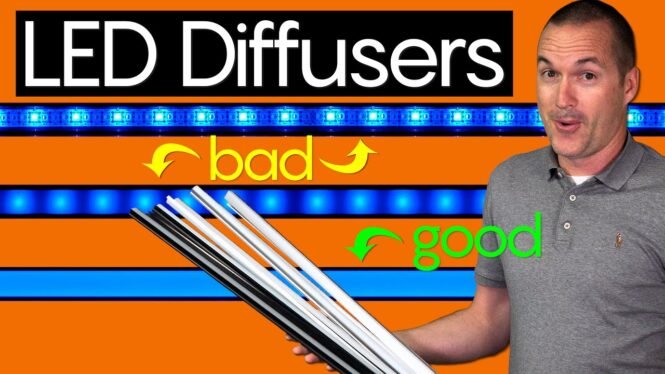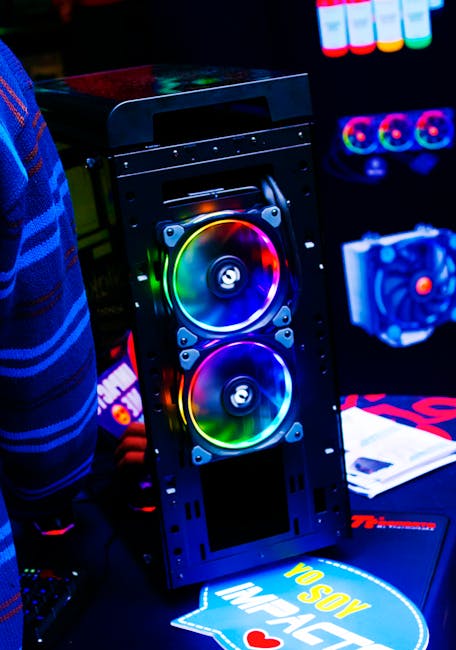
When it comes to LED strip lighting there
are two very different styles. On TikTok you’ve got highly exposed, bare,
flashing, um… LED strips, and pretty much everyone else
wants soft diffuse light with no hot spots and no visible individual LED dots. The best way to get that second look is with
LED diffuser channels but with those you’ve so many choices to make. Is black or silver better? What about deep or shallow? Does the shape of the plastic cover matter? And what LED strip density should you use? Does all that sound overwhelming to you? Well don’t worry, answers to all those questions
and a lot more are coming up today on the hook up. As I said If you’ve ever looked on Amazon
for LED diffuser channels you know there are a ton of different vendors, styles and colors,
but are those things really important? To answer that question once and for all I
spent a few hundred dollars to buy basically every variation of LED channel, and every
LED strip density to figure out which combinations give you the most diffuse light with the smallest
amount of brightness reduction for the least amount of money.
For channel types we’ve got shallow unfinished
aluminum, deep unfinished aluminum, deep black aluminum, 45 degree deep unfinished aluminum
and 45 degree shallow unfinished aluminum. For the diffusers on our flat channels we’ve
got flat milky white, curved milky white, flat smoky black and this unique tall milky
white diffuser, while on the 45 degree channels we’ve got milky white flat and milky white
curved. The general rule that I’ve always heard
is that to avoid individual bright spots your LEDs should be farther away from the diffuser
than they are from each other, and most LED strips come in 3 different densities: 30 LEDs
per meter, 60 LEDs per meter and 144 LEDs per meter so right away it seems like it might
be close to impossible to get a completely diffused look from the 30 LEDs per meter density
since using that general rule our diffuser would need to be over 32.5mm tall, but there’s
only one way to find out, so lets get testing.
First, let’s look at deep vs shallow channels. Starting out with 30 LEDs per meter you can
see the shallow channel on the left and the deep channel on the right and as we would
expect, the deep channel does a significantly better job diffusing light at each brightness
level, but the dots are still visible. At 60LEDs per meter the deep channel is really
close to achieving the perfectly diffuse look, and at 144 LEDs per meter all the hotspots
are gone.
So for the most diffuse look there’s no
question that deep channels are significantly better than shallow channels but there is
a drawback. I also measured the drop in brightness compared
to no diffuser at all, and on average the deep channel led to a 36% drop in brightness
vs only 22% for the shallow channel, so if you’re just looking for a channel to conceal
or mount your LEDs and they won’t be directly visible than shallow channels are the way
to go. Next, lets look at channel color. I’ve got two identical channels, one black
and one bare aluminum and for control I’ll use the flat diffuser on both. On the left is the black channel, and on the
right is the bare aluminum channel and you can see at 30 LEDs per meter neither of them
can completely diffuse the LED strips, but the black channel is significantly dimmer
than the bare aluminum.
At 60 LEDs per meter the unfinished aluminum
does a slightly better job at diffusing while maintaining better brightness and the same
is true with 144 LEDs per meter. According to my measurements the average brightness
reduction for the black deep channel with a flat diffuser was 58% vs just 36% brightness
reduction for the bare aluminum channel with flat diffuser. Moral of the story, unless you really need
it for your aesthetic, avoid the black channels in favor of bare aluminum. Next let’s look at diffuser shapes. I’ve got 3 different shapes to test: a flat
diffuser that sits flush with the top of the channel, a curved diffuser that the manufacturer
calls their spotless diffuser which sits above the channel and also has a thicker area near
the middle of the curve, and then what I call a tented diffuser that stands up above the
channel to give additional height and some side profile light as well.
Unfortunately the tented diffuser only fits
on the shallow channel that it came with, so I can’t test the deep channel with the
tented diffuser. Starting out with 30 LEDs per meter, we’ve
got the bare aluminum deep channel with flat diffuser on the left and the same bare aluminum
deep channel with the spotless diffuser on the right. At 50% and 100% brightness the spotless diffuser
doesn’t disappoint and gives as close to a spotless look as you can get with a 30 LED
per meter strip. Switching it out for 60LEDs per meter the
spotless diffuser lives up to its name again giving us the first time we’ve seen a completely
spotless look through all the colors and brightness levels.

Unfortunately, the spotless diffuser isn’t
available to purchase with a shallow aluminum channel, but for comparison’s sake here’s
what that combination looks like at 30 and 60 LEDs per meter, which although not perfect
is a huge improvement over the flat diffuser. Next, lets see how the deep channel with the
spotless diffuser compares to the tented diffuser. At 30 LEDs per meter the advantage definitely
goes to the spotless diffuser, but at 60 LEDs per meter it’s a bit of a toss up, because
even though the spotless diffuser on the right does a slightly better job giving that completely
spotless look it does cause a brightness reduction of 56% vs just 35% brightness reduction with
the tented diffuser, plus the tented diffuser also gives some side profile light which I
think looks pretty neat.
At 144 LEDs per meter they are both completely
spotless but as expected the tented diffuser is significantly brighter. Last for completeness, let’s quickly look
at diffuser colors. On some listings you may see the option of
milky white or smoky grey diffusers, but in my testing I wouldn’t even call the smoky
grey version a diffuser. It does hide the LED strip when the power
isn’t on, but you can see that once they do turn on the entire strip and every LED
is visible. On left is 60 LEDs per meter with deep black
channel and a smoky gray diffuser, and on the right is deep black channel with a milky
white diffuser. The craziest part about this is that they
both result in about the same amount of brightness reduction which is around 58%.
So conclusion and recommendation time. The sweet spot for LED density in terms of
price, power consumption and aesthetic is definitely 60 LEDs per meter and my two favorite
diffusers to use with those strips are the shallow aluminum channel with the tented diffuser
and the deep aluminum channel with the spotless diffuser. Between the two the spotless diffuser is slightly
more spotless, but the tented diffuser looks better when it’s off, has a better mounting
system, less brightness reduction and also gives that side profile light that I think
looks pretty cool.
30 led per meter strips on the other hand
are really hard to completely diffuse. If you’re using them as indirect light then
no diffuser is best since that will give you the most brightness, but if you want to conceal
them then a shallow channel and flat diffuser results in the smallest amount of brightness
reduction. If you absolutely need to use the 30 LEDs
per meter density in a visible location then the bare aluminum deep channel with the curved
spotless diffuser did the best job reducing hotspots, but still with less than perfect
results and a 56% decrease in brightness. Perhaps unsurprisingly black channels lower
brightness and lower diffusion due to their lower overall reflectivity and should be avoided
unless you absolutely need them. All these same principles apply to the 45
degree channels, except the curved diffuser version doesn’t have the thicker part near
the center like the spotless diffuser does and as a result doesn’t work quite as well.
Still the curved diffuser does a significantly
better job than the flat diffuser, but neither of them are able to achieve a completely spotless
look with 30 or 60 LEDs per meter and the flat diffuser can’t even do it at 144 LEDs
per meter. If you’re wondering I did pay full price
for all these diffusers and as always there are no sponsored reviews on my channel. However, the links in the description are
affiliate links so if you appreciate the time and effort that it takes me to make these
videos and you want to show some thanks, then go ahead and use those links because I do
get a small portion of the sale at no cost to you. Thank you so much to all of my patrons over
at patreon for your continued support of my channel, and if you’re interested in supporting
my channel please check out the links in the description.
If you enjoyed this video please hit that
thumbs up button and consider subscribing, and as always, thanks for watching the hookup..

